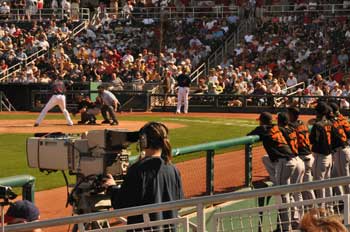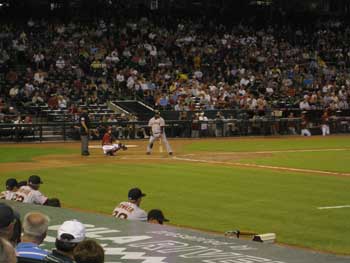Physics of Baseball

Spring has sprung and the batters have swung. Baseball season has officially started. Although the games we watch in the big leagues could be drastically different by changing only one aspect: the bat. The argument between wooden and metal bats has been an ongoing struggle between players and fans alike. Players claim to “know” that they can hit better with metal bats, and fans claim they can “tell.” For such a controversial subject, there have been only a few studies that have tried to make or break this myth.
In the 1970s, metal bats were introduced into the world of baseball. They were cheaper and more efficient. Since metal bats rarely break, it was more cost efficient for a team to spend the money on 12 bats per season, verses the 62 wooden bats they might have to buy and frequently replace. Shortly after they were introduced, metal bats became a safety issue. With players being able to hit the ball faster and farther, players in the outfield were put in danger. The major leagues decided to stick with wooden bats because no one wanted to see star outfielders, like the San Francisco Giant's Cody Ross, put in danger because of a cost-effective bat. This decision has remained the same, although the bats themselves have not.

To understand the difference between metal and wooden bats, we must first talk about baseball bats in general and an important factor known as the center-of-percussion or COP. The COP is known to most players as the “sweet spot.” This spot is located 6-8 inches down from the bigger end of the bat. When you hit the ball on this exact spot, the energy is transferred directly and equally, which cuts down on the amount of vibration that travels through the bat. If the batter hits the ball higher, the bat will try to spin backward and find its center, which causes the batters grip to open up. If the ball is hit lower than the COP, it sends energy up towards the batters hands.
A metal bat generally has a larger COP area, which would allow the batter a larger area to hit the “sweet spot.” This puts metal bats at an unfair advantage because there is more surface area to strike the COP. Bats also have what's called a center-of-mass or CM. The closer the CM is to the handle of the bat, the easier it is to swing. Metal bats have a CM that is directly at the top of the handle, where as the CM of wooden bats is 3-4” higher. This allows metal bats to be swung harder and faster than wooden bats. In addition, the trampoline effect must be taken into consideration. This is a complicated concept, but it can be put in easier terms when referring to baseball. When the ball is struck by a wooden bat, the bat absorbs some of the energy as the two meet. With a metal bat, the bat is actually giving out energy when the ball strikes it, causing a trampoline effect. This effect adds energy to the process making, you guessed it, the ball travel faster and farther.

In a 1977 study, it was concluded that metal bats resulted in a ball speed of about 4 mph faster than a wooden bat. Although, two other studies done around the same time showed 1) there was no difference between the performance of metal and wooden bats and 2) that wooden bats actually outperformed metal bats. This seems contradictory, but the other factors at play have to be considered. How fast a ball is thrown and how fast the bat is swung both have an effect on the ball speed. These studies attempted to make these factors neutral by controlling the studies, but in most cases it was ineffective.
Since these studies have been performed, the standards and materials that make metal bats have changed. So although metal bats have been thought to outperform wooden bats, they have since changed, and the bats used in these 1970s studies would be outlawed by the college baseball rules that are in place today. Under the current regulations and standards, there have been few studies that aid in settling this controversy. A study conducted at Brown University discovered that some metal bats can drastically outperform wooden bats. They discovered that this is due to the swing speed that is allowed with a metal bat in addition to the trampoline effect. Until additional studies have been conducted, the best personal way to find out is to “Play ball!”














